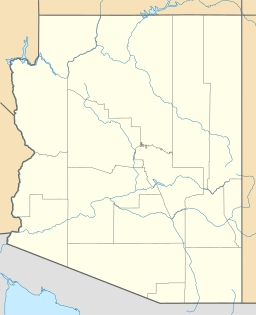Tumamoc Hill
| Tumamoc Hill | |
|
View across the Tucson Basin towards Tumamoc Hill (left) and "A" Mountain (center)
|
|
| Country | United States |
|---|---|
| State | Arizona |
| Region | Sonoran Desert |
| District | Tucson, AZ |
| Location | Tucson Mountains |
| - coordinates | 32°12′46″N 111°00′22″W / 32.21278°N 111.00611°WCoordinates: 32°12′46″N 111°00′22″W / 32.21278°N 111.00611°W |
| Highest point | |
| - elevation | 3,108 ft (947 m) |
| Topo map | USGS Cat Mountain, AZ |
Tumamoc Hill (O'odham: Cemamagĭ Doʼag) is a butte located immediately west of "A" Mountain and downtown Tucson, Arizona. It is home to many radio, television, and public safety transmitters. The University of Arizona (UA) owns a 340-acre (1.4 km2) preserve and leases another 509 acres (2.06 km2) as a research and education facility. The Steward Observatory maintains a small astronomical observatory with a 20-inch (510 mm) telescope on the hill. Besides being a prominent landmark, Tumamoc Hill has a long and varied history, and is currently an important site for ecological and anthropological research as well as a refuge and a recreational option for the people of Tucson.
Tumamoc, which is an O'odham word for "regal horned lizard", was a home to the ancient Hohokam people. It is the site of the earliest known trincheras village, consisting of 160 foundations of round stone structures, as well as large stone perimeter walls. Over 460 petroglyphs and a prehistoric garden beside the hill provide further evidence of Tumamoc’s importance to these people. For long after that time, 1,300 years ago, the site continued to provide resources to the Tohono O'odham, Akimel O'odham, and the Hopi. It has also been reported to be a burial site for the Apache and the O'odham.
Captain Juan Mateo Manje, a Spanish military commander, wrote the following about Tumamoc Hill after seeing it on one of his expeditions with Father Kino between 1693 and 1701:
Note that Manje refers to "former" wars, indicating that the fighting took place in prehistoric times (before the arrival of Europeans). Being that the O'odham are probably descendants of the Hohokam, it does not seem unreasonable to conclude that the Hohokam, who lived only a few centuries before Manje's expedition, did as their later relatives apparently did and used their trincheras to fall upon their enemies and kill them.
...
Wikipedia


